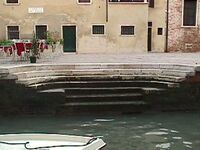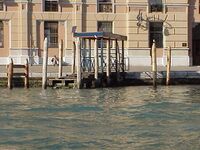Dock: Difference between revisions
No edit summary |
No edit summary |
||
| Line 1: | Line 1: | ||
''This article contains information about a typical Venetian dock. For a list of docks, see [[Docks]].'' | |||
[[File:022-15.jpg|right|thumb|200px|An example of a ''[[Riva (Dock)|Riva]]''.]] | [[File:022-15.jpg|right|thumb|200px|An example of a ''[[Riva (Dock)|Riva]]''.]] | ||
Latest revision as of 03:09, 13 January 2014
This article contains information about a typical Venetian dock. For a list of docks, see Docks.

Docks in Venice are used for unloading and loading cargo and people from/to boats. Docks serve the same purpose as temporary "loading zones" in other cities and they can only be used for short periods of time. There are three types of docks.

Dock Construction
A typical dock in Venice is made of stone. The only exception would be pontili, which are made of wood.

Components
Typical docks are equipped with rings, made of iron or steel, and/or poles, that are generally made of wood. Some docks have railings, which are made of metal or wood.
Dock Inspections
Condition Ratings
When surveys are conducted, the condition of each dock was assessed according to the scale below.[1]
Usability Ratings
The usability of a dock can be categorized according to the scale below.[2]